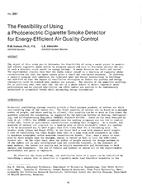
2891 — The Feasibility of Using a Photoelectric Cigarette Smoke Detector for Energy-Efficient Air Quality Control
- Comments Off on 2891 — The Feasibility of Using a Photoelectric Cigarette Smoke Detector for Energy-Efficient Air Quality Control
- ASHRAE
The object of this study was to determine the feasibility of using a smoke sensor to monitor and control cigarette smoke levels in occupied spaces and also to determine whether the use of such a detector could result in energy savings. A smoke detector was built and tested. The experimental results show that the smoke sensor output is a function of cigarette smoke concentration and that the smoke sensor gives a rapid and continuous response . In addition, a computer program that simulates the transient mass and energy interactions in buildings was modified so that the impact of ventilation strategies on indoor air quality and energy consumption could be studied when smokers are present. The results of the numerical modeling for an arbitrary test case show that the use of a smoke sensor to detect cigarette smoke particulates and to control ventilation can allow indoor air quality to be continuously maintained at acceptable levels while minimizing energy consumption.
Units: Dual
Citation: ASHRAE Transactions, 1985, vol. 91, pt. 2A, Honolulu, HI
Product Details
- Published:
- 1985
- Number of Pages:
- 10
- File Size:
- 1 file , 650 KB
- Product Code(s):
- D-HI-85-2891

